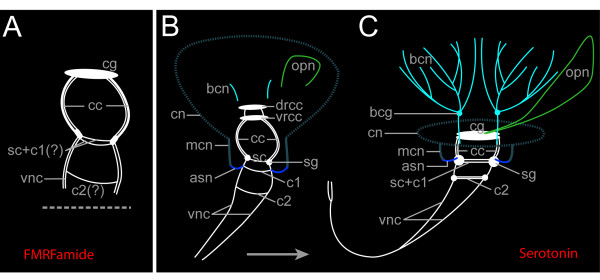Figure 5.
Central nervous system (CNS) and anteriorperipheral nervous system in Spirorbis cf. spirorbis. (A) shows the FMRFamidergic and (B) and (C) the serotonergic ganglia and nerves. Apical is to the top. The CNS structures are depicted in white. (A) Settled larva. The neuropeptide FMRFamide is restricted to the CNS structures such as the cerebral ganglion (cg), the circumesophageal connectives (cc), the ventral nerve cords (vnc), the subesophageal commissure, most likely with adjacent first commissure [sc + c1 (?)], and an additional ventral commissure [most probably the second commissure, c2(?)]. These commissures most probably correspond to the ones shown in (B) and (C). (B) Settled larva. The dorsal root (drcc) and the ventral root of the circumesophageal connectives (vrcc) appear as separate entities. The two strands of the ventral nerve cord (vnc) are linked to each other via a subesophageal commissure (sc) in the position of the subesophageal ganglia (sg), and via two additional commissures (c1 and c2). The branchial crown neurons (bcn) and the neurons of the operculum (opn) start to form. They are enclosed in the network of the collar neurons (cn) emanating from the main collar neuron (mcn) on each side of the body. The latter are connected via the anterior segmental neurons (asn) to the CNS. (C) Settled juvenile. Note the condensation of the CNS: the strands of the ventral nerve cords (vnc) are fused in the posterior body, the commissures c1 and c2 are shifted forward, and the circumesophageal connectives (cc) are shortened. bcg, branchial crown ganglia.

